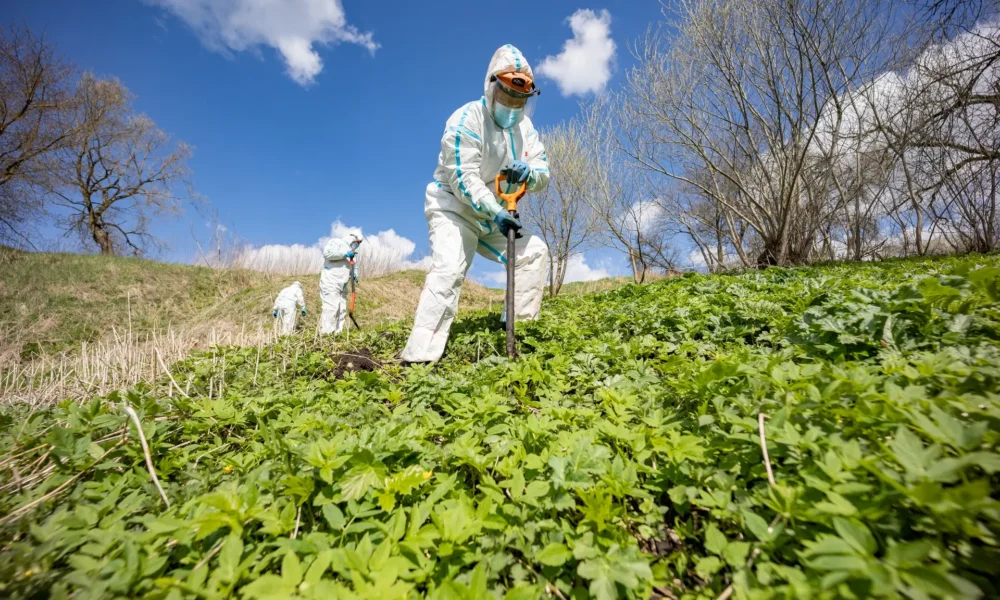Invasive Species: Sosnowsky’s Hogweed Being Eradicated. Goldenrods and the Spanish Slug Are Next in Line
Cities provide the perfect breeding ground for invasive plant species—they reproduce rapidly, outcompete native species, and disrupt ecosystems. In Vilnius, the most serious threats are posed by Sosnowsky’s hogweed, Canadian and giant goldenrods, boxelder maples, large-leaved lupines, and daisy fleabane. Himalayan balsam is also spreading rapidly in forests and along riverbanks.
This year, the capital is taking active steps to combat invasive species. With the support of scientific experts, plans are being prepared to eradicate Sosnowsky’s hogweed, Canadian goldenrods, and the invasive Spanish slug (Arion vulgaris). In addition, thickets of boxelder maples will be removed.
Goldenrods Covering Increasingly Larger Areas
Dr Zigmantas Gudžinskas, Senior Researcher at the Nature Research Centre, notes that invasive species can now be found in nearly every green space throughout the city.
In recent years, giant and Canadian goldenrods have spread particularly widely. In 2023, about 8 hectares of these plants were mowed down, and this year there are plans to continue their eradication more systematically. Goldenrods spread both by seed and rhizome, which is why it is crucial to mow them before they begin to produce seeds—typically in July and August.
Another species that is becoming increasingly common is Japanese knotweed. Although residents plant it in their home gardens, it has already been seen in the wild and has the potential to become a dangerous invasive species.
Private Properties Are Also Subject to Eradication of Invasive Species
The Vilnius City Municipality is continuing the systematic eradication of Sosnowsky’s hogweed. Last year, the plant was removed from as many as 170 locations, which is approximately 64 hectares. While some areas have seen a decrease in the number of plants, as many as 30 new outbreak sites have been identified.
“We are finalizing a new action plan that will include the eradication of Sosnowsky’s hogweed, goldenrods, and the Spanish slug. This plan will also cover private properties,” Emilis Tamošiūnas, Chief Specialist at the Environmental Protection Programs and Greenery Management Division of the Vilnius City Municipality, said. The most effective methods of eradication will be chosen in consultation with scientists.
Boxelder Maples to Be Removed in Šeškinė Residential Area
Efforts to control boxelder maples are being intensified—they are being cleared from the banks of the Neris and Vilnia rivers, with their saplings regularly mowed. This year, eradication will also take place in the Geomorphological Reserve of the slopes Šeškinė residential area, located between Akropolis shopping mall, Geležinio Vilko, and Ukmergės streets. Smaller trees will be cut down, while larger ones will be dried out by injecting herbicide into their trunks. This is the most effective method of preventing regrowth.
However, no herbicides are used near water bodies due to the potential risk to aquatic ecosystems.
Green Waste—A Hidden Threat to Nature
Invasive plants thrive particularly well in neglected areas, construction sites, and often spread with imported soil. For example, during the construction of the Western Bypass, seeds of various invasive species—such as Sosnowsky’s hogweed, large-leaved lupines, daisy fleabane, rugosa roses, and goldenrods—were unintentionally brought in with the soil.
Outbreaks of invasive species often result from the improper disposal of green waste by residents.
“Gardeners and allotment owners often think it’s harmless to throw out grass clippings or pulled weeds from their plots because it’s organic and will decompose quickly. However, non-native plant material dumped in nature begins to spread uncontrollably and suppress native species,” Dr Gudžinskas warned.
Compost bins should also be securely closed, as they provide ideal conditions for invasive Spanish slugs to thrive.
Invertebrates: Another Threat
A true nightmare for gardeners—the Spanish slug (Arion vulgaris)—has reached the Vilnius region, most likely via imported seedlings. “Soil is like a living, complex organism. It contains plant seeds, fungal spores, insect larvae and eggs, and various microorganisms. All of this can be brought in from other countries, non-native organisms begin to spread and harm the environment, as they have no natural predators here,” Dr Gudžinskas explained speaking about the spread of invasive species.
Invasive Species Alter Entire Ecosystems
Invasive plants not only outcompete native species but also change the composition of the soil. For instance, lupines release large amounts of nitrogen, while goldenrods also affect soil microorganisms. These changes lead to the disappearance of natural habitats and a decline in animal diversity.
Research shows that invasive, abundantly flowering plants attract more pollinators. This leaves native plants under-pollinated and unable to produce seeds.
Dr Gudžinskas emphasizes that combating invasive species is only possible through cooperation: “Municipalities must consistently eradicate invasive species in public spaces, while residents should do the same on their own properties, compost responsibly and choose native plants for the landscaping of the properties.”
